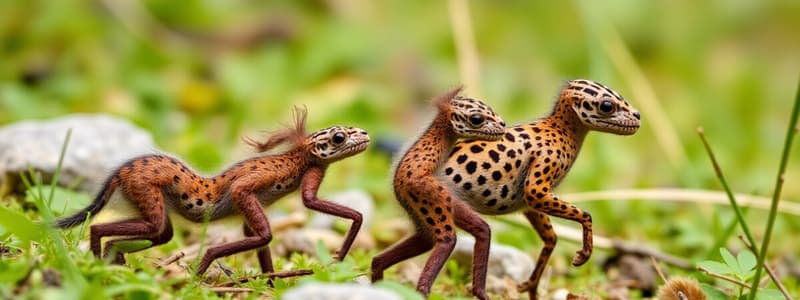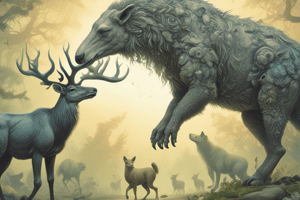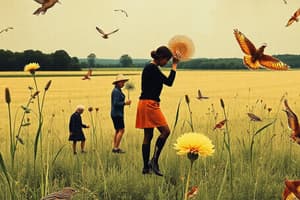Podcast
Questions and Answers
Which of the following scenarios best illustrates coevolution?
Which of the following scenarios best illustrates coevolution?
- Humans domesticate cows, leading to changes in both human ability to digest lactose and in cow milk production. (correct)
- A forest fire causes a population of trees to evolve thicker bark.
- A species of fish evolves brighter colors to attract mates.
- A population of birds migrates to a new island and begins to adapt to the local food sources.
What role does ecology play in the coevolution of humans and agricultural species?
What role does ecology play in the coevolution of humans and agricultural species?
- Ecology, including culture, produces selection pressures that influence the traits favored in both humans and the species they interact with. (correct)
- Ecology ensures that agricultural species remain genetically diverse.
- Ecology prevents humans from over-exploiting agricultural species.
- Ecology determines the genetic mutations that arise in both humans and agricultural species.
What is the significance of lactase persistence in human populations?
What is the significance of lactase persistence in human populations?
- It causes lactose intolerance in infants.
- It allows humans to digest lactose into adulthood, providing a nutritional advantage in some cultures. (correct)
- It prevents humans from digesting milk effectively.
- It has no impact on human health or nutrition.
What is the function of the lactase enzyme?
What is the function of the lactase enzyme?
What is the wild-type (WT) condition regarding lactose tolerance in adult humans?
What is the wild-type (WT) condition regarding lactose tolerance in adult humans?
Why is the prevalence of lactase persistence higher in some human populations of European origin?
Why is the prevalence of lactase persistence higher in some human populations of European origin?
What evidence supports the hypothesis that substitutions in the lactase gene are causal variants for lactase persistence?
What evidence supports the hypothesis that substitutions in the lactase gene are causal variants for lactase persistence?
What prediction would support the hypothesis that dairy agriculture imposed evolution by natural selection on traits that cause lactase persistence?
What prediction would support the hypothesis that dairy agriculture imposed evolution by natural selection on traits that cause lactase persistence?
What does the independent evolution of lactase persistence in different human populations suggest?
What does the independent evolution of lactase persistence in different human populations suggest?
What is meant by 'convergent evolution'?
What is meant by 'convergent evolution'?
Studies of Neolithic human remains suggest what about lactose digestion?
Studies of Neolithic human remains suggest what about lactose digestion?
What is the significance of replicated associations between genotype and phenotype in the context of lactase persistence in African cultures?
What is the significance of replicated associations between genotype and phenotype in the context of lactase persistence in African cultures?
In Central Asia, mutations associated with lactase persistence have been detected in samples from 5,000 years ago, but have not increased in frequency. What does that suggest?
In Central Asia, mutations associated with lactase persistence have been detected in samples from 5,000 years ago, but have not increased in frequency. What does that suggest?
To understand the imprints of coevolution in genomes, what field's principles are applied?
To understand the imprints of coevolution in genomes, what field's principles are applied?
How might selection typically affect genetic variability in regions of the genome?
How might selection typically affect genetic variability in regions of the genome?
What is expected at selected sites compared to the 'rest of the genome'?
What is expected at selected sites compared to the 'rest of the genome'?
If all mutations affecting fitness are neutral, what will be the relative rates of substitution for replacement (non-synonymous) and synonymous sites?
If all mutations affecting fitness are neutral, what will be the relative rates of substitution for replacement (non-synonymous) and synonymous sites?
If all mutations affecting fitness are deleterious, what will be the relative rates of substitution for synonymous sites compared to replacement sites?
If all mutations affecting fitness are deleterious, what will be the relative rates of substitution for synonymous sites compared to replacement sites?
If all mutations affecting fitness are beneficial, what will be the relative rates of substitution for replacement sites compared to synonymous sites?
If all mutations affecting fitness are beneficial, what will be the relative rates of substitution for replacement sites compared to synonymous sites?
What is 'genetic hitchhiking?
What is 'genetic hitchhiking?
How does natural selection, acting on lactase persistence, change the genetic makeup of a population over time?
How does natural selection, acting on lactase persistence, change the genetic makeup of a population over time?
What is the relationship between cattle domestication and lactase persistence in some human populations?
What is the relationship between cattle domestication and lactase persistence in some human populations?
What impact does selection have on genomic regions near a beneficial mutation that is undergoing a selective sweep?
What impact does selection have on genomic regions near a beneficial mutation that is undergoing a selective sweep?
Why is understanding the coevolution of humans and agricultural products relevant?
Why is understanding the coevolution of humans and agricultural products relevant?
A population of butterflies evolves to mimic the wing patterns of a toxic butterfly species. Which evolutionary concept best describes this scenario?
A population of butterflies evolves to mimic the wing patterns of a toxic butterfly species. Which evolutionary concept best describes this scenario?
What is the relationship between natural selection and coevolution?
What is the relationship between natural selection and coevolution?
In a coevolutionary relationship, what is the consequence of one species adapting to another?
In a coevolutionary relationship, what is the consequence of one species adapting to another?
Which field of biology is LEAST relevant to understanding coevolution?
Which field of biology is LEAST relevant to understanding coevolution?
What is the most likely explanation for longer lines (longer sections of the genome that are totally homozygous) in the 'Lactose intolerant Africans' group as shown in the African G/C-14010 graph?
What is the most likely explanation for longer lines (longer sections of the genome that are totally homozygous) in the 'Lactose intolerant Africans' group as shown in the African G/C-14010 graph?
Which one of the statements is NOT true about the 'Note' about 'These calculations require accounting for the number of sites that could potentially be synonymous vs. replacement to make it a fair test!'?
Which one of the statements is NOT true about the 'Note' about 'These calculations require accounting for the number of sites that could potentially be synonymous vs. replacement to make it a fair test!'?
Which of the statements is wrong about what the lactose persistence evolution in humans does NOT suggest?
Which of the statements is wrong about what the lactose persistence evolution in humans does NOT suggest?
Why is it useful to look at several independent lines of evidence when determining if a trait is due to chance or determinism?
Why is it useful to look at several independent lines of evidence when determining if a trait is due to chance or determinism?
What three things should we expect to see if selection is affecting which mutations persist through time?
What three things should we expect to see if selection is affecting which mutations persist through time?
Flashcards
What is coevolution?
What is coevolution?
Reciprocal evolutionary responses between two species, where each species' adaptations influence the other. Selection acts reciprocally.
What is Sexual Coevolution?
What is Sexual Coevolution?
Evolutionary responses between the two sexes of a single species due to selection imposed by the other sex.
What is human-agricultural coevolution?
What is human-agricultural coevolution?
Reciprocal evolutionary responses where humans and their agricultural species influence each other's evolution through selection.
Human Ecology
Human Ecology
Signup and view all the flashcards
What is lactase?
What is lactase?
Signup and view all the flashcards
Lactase production in adulthood
Lactase production in adulthood
Signup and view all the flashcards
What is lactase persistence?
What is lactase persistence?
Signup and view all the flashcards
Lactase gene in Europeans
Lactase gene in Europeans
Signup and view all the flashcards
What is convergent evolution?
What is convergent evolution?
Signup and view all the flashcards
Lack of lactase frequency increase
Lack of lactase frequency increase
Signup and view all the flashcards
How can we understand coevolution in genomes?
How can we understand coevolution in genomes?
Signup and view all the flashcards
What is a non-synonymous mutation?
What is a non-synonymous mutation?
Signup and view all the flashcards
What are synonymous mutations?
What are synonymous mutations?
Signup and view all the flashcards
What is genetic hitchhiking?
What is genetic hitchhiking?
Signup and view all the flashcards
Genetic variation after sweeps
Genetic variation after sweeps
Signup and view all the flashcards
Study Notes
- EEB405 Temperate Field Biology applications are open
- Consider applying for a field course to learn field research in ecology and evolution
- Dates: May 18 to 31, 2025
- Location: Koffler Scientific Reserve
- The application deadline is January 31, 2025
- More info: www.ksr.utoronto.ca
Beyond BIO Activities
- Beyond BIO events are optional and meant to be fun and informative for BIO220 students
- More info can be found on Quercus under Modules -> Beyond BIO
Upcoming Beyond BIO Events
- BIO220 Social! will be held Tuesday January 14th at 2:10 pm in Room RW 010 in Ramsay Wright, with trivia and snacks
- Birds & Wildlife of Toronto on Thursday January 23rd from 11:10 am – 12:00 pm in room RW 432 with refreshments and snacks
Lecture 2: Human – Agricultural Coevolution
- Addresses coevolution, how humans coevolve with agricultural species, and the imprint of coevolution on genomes
Coevolution Explained
- Coevolution involves reciprocal evolutionary responses between a pair of species, driven by selection imposed by each other
- Sexual coevolution involves reciprocal evolutionary responses between the two sexes, again caused by selection imposed by each other
- Human agricultural coevolution occurs between humans and their agricultural species due to selection imposed by each other
- Evolution by natural selection is a process that relies on ecology to provide selection
- Genetics provides the material transmitted across generations
Human Ecology
- Includes culture and the organisms humans interact with
Human Milk Digestion
- Humans digest milk using the lactase enzyme to get useful milk-based products
Lactase Production
- Usually declines in adulthood
- In people of North European origin, lactase production persists through adulthood, enabling milk digestion
- A decline in lactase results in lactose intolerance
- Wild-type means to be lactose intolerant as an adult
Lactase Persistence
- Is present in many humans of European origin, allowing for the digestion of milk
- Changes in the lactase gene in European populations strongly correlated with the ability to digest lactose as an adult
- The substitutions are the causal variants
- The substitutions were favored by natural selection
Prediction
- Other human populations with lactase persistence should have the same substitutions or similar enzyme changes
- Populations practicing dairy agriculture should have lactase persistent phenotypes, and demonstrate genetic evidence of past selection at the lactase gene
Populations in Africa
- Practice dairy farming, some show this lactose tolerance
- African cultures with dairy farming also have distinctive forms of the lactase gene
- DNA sequence differences correlate significantly with the ability to digest lactose
Conclusions
- Strengthens the inference that these molecular variants affect the phenotype
- Independent phenotype evolution in different populations supports the driving force of natural selection
Chance vs Determinism
- Single events are due to chance alone or to deterministic processes
- Independent lines of evidence confirm deterministic explanations by rejecting chance
Convergent Evolution
- Is the independent evolution of the same trait in different groups and could be populations or species
- Allows for stronger evidence that selection is at work
- In the case of lactase persistence, convergent evolution appears to use the same genes
Timeline
- Studies of Neolithic human remains (10,000 years B.C.E.) suggest that they were unable to digest lactose as adults
- Cattle domestication did not occur until approximately 7,500 to 9,000 B.C.E.
- Lactase persistence in Europeans subsequently evolved around 5,000 to 7,000 B.C.E.
Lactase Gene Studies
- Studies show mutations in lactase associated with lactase persistence into adulthood
- Has strong evidence of replicated association between genotype and phenotype
- Independent derivation supports adult milk digestion as an example of convergent evolution
Salivary Amylase
- AMY1 encodes salivary amylase, which begins starch digestion in the mouth
- AMY1 shows copy number variation
- More copies, more enzyme, more digestion
- AMY1 copy number expansion in humans linked to agriculture
Lactase Persistence Mutations
- Have been detected in older Central Asian samples (5,000 years ago)
- Despite the presence of the mutation, it has not increased in frequency
Fermented Milk
- Central Asia produces fermented milk products and LP alleles are is present without increasing in frequency
- Hypothesis: Fermented milk products contain bacteria that ferment milk are ingested with it, aiding digestion
- Allows for calories, calcium, vitamin D, lipids, and proteins to be consumed
Genetic Evidence
- It is evident of past selection at the lactase gene
- Population genetics are applied
Genomic Differences
- The fate of mutations that change amino acids (replacement = non-synonymous) versus those that do not (synonymous)
- Regions of the genome that experience selection will have lower genetic variability
- More differentiation between populations at selected sites than the 'rest of the genome'
Types of Mutation
- Neutral will result in similar properties of both replacement and synonymous mutations
- Deleterious will result in lower population frequencies for replacement mutations
- Beneficial mutations will result in more replacement mutations than synonymous mutations
Alleles
- Longer lines show longer sections of the genome that are totally homozygous
- This indicates low variation in this region of the genome
- This natural cause selection is for evolution of lactase persistence
Molecular Level
- There is evidence of adaptation in lactase.
Key Concepts
- There is coevolution, convergent evolution, chance and determinism, and pop gen predictions of selection
- Includes what selection does to variation and how rate of recombination affects this
- Allele frequency differences indicate adaptation
Studying That Suits You
Use AI to generate personalized quizzes and flashcards to suit your learning preferences.




